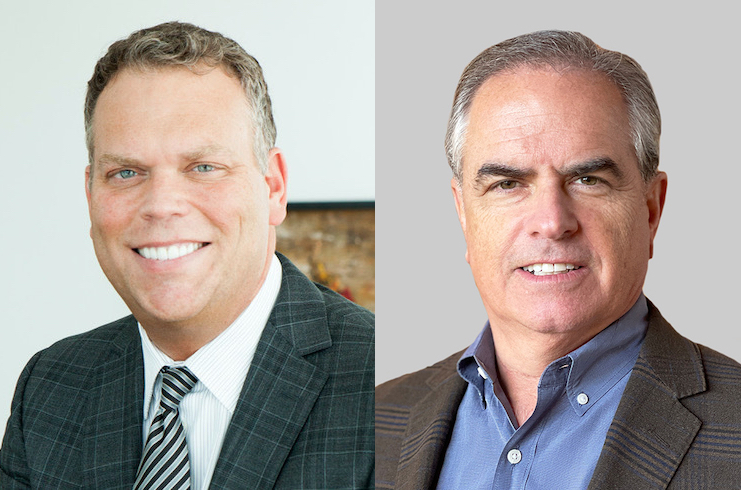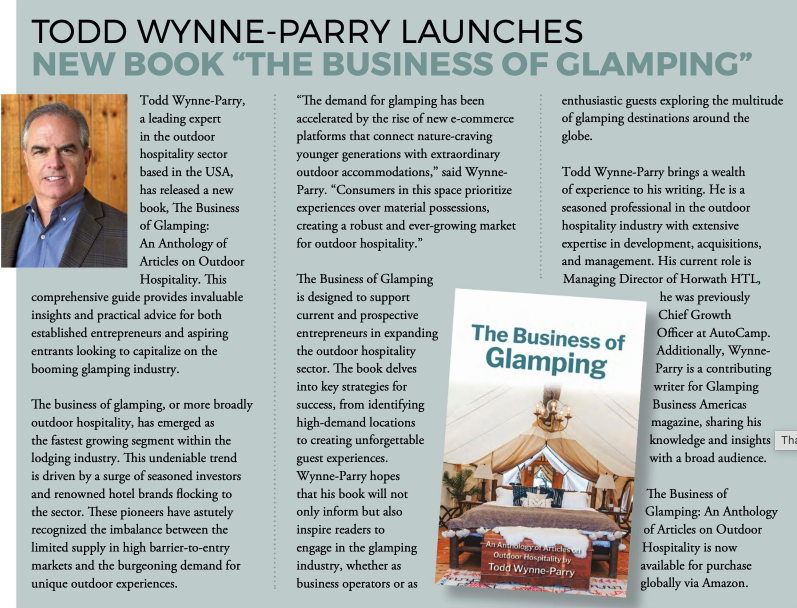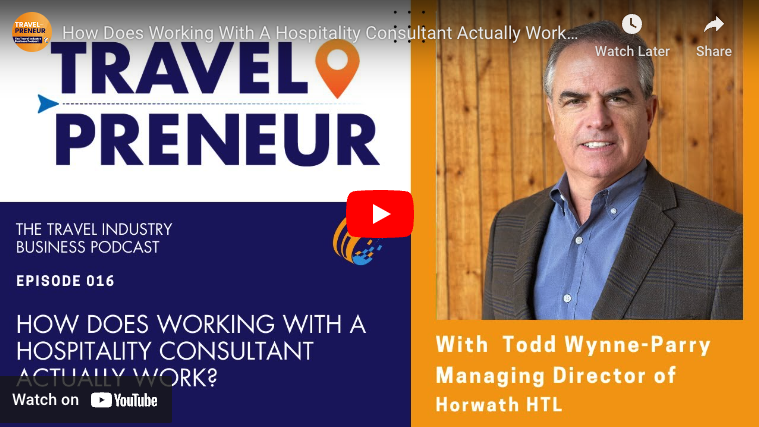
Getting Outdoors: Horwath HTL’s Oregon Managing Director and Global Chairman on Outdoor Hospitality
Date: February 3, 2022
The following article appeared in Lodging Magazine here.
New Managing Director of Horwath HTL Oregon, Todd Wynne-Parry recently joined his colleague, John Fareed, who is Global Chairman of the independent hospitality advisory brand, to debrief at the Americas Lodging Investment Summit (ALIS) and describe for LODGING the appeal of the outdoor hospitality space and the challenges that can come with getting up and running in this new segment of the hospitality industry.
What is the appeal of the outdoor space?
Wynne-Parry: The core need is to get into nature, to get out and do something—go hiking, biking, fishing, do whatever you want to do in the outdoors. This is something people have been gravitating to—especially since the pandemic—regardless of their economic capability. It can be anything from a tent or RV to the luxury outdoor experience known as glamping.
I myself was drawn to the outdoor space, as well as the opportunity to make an impact on it, by joining Horwath HTL, partly due to my own love of the outdoors; but I also recognized that this was where the creative younger generation of entrepreneurs wanted to be. Having already had a great career dealing with lifestyle and boutique hotels, I jumped at the chance to get in early with this new burgeoning sector of the hospitality industry and to bring the expertise that I’ve had through the years—in things like growing and brands, calling markets, and designing the hotels to fit markets—to this new sector.
How are you planning to integrate your involvement with outdoor space with your other hospitality interests?
Fareed: We’re a 100-year-old firm with 52 offices across 40 countries, and want to be as broad and deep as possible with our hotel tourism and leisure services. That means adding service lines wherever possible as clients demand them, and since last year, we have been seeing great demand in this sector. We are thrilled to have Todd [Wynne-Parry] on board and hope he’ll bring his knowledge, expertise, and reputation to benefit our partners globally.
In the past, you stressed the importance of client relationships to your advisory business. Is this still a high priority for Horwath HTL?
Fareed: Absolutely, but it’s not just with our clients. I travel extensively for meetings with our teams and clients both to advance our strategic marketing initiative and to continue building and strengthening relationships and connections. For example, just in the last two weeks, I was in London, then Dublin, where we have new offices, meeting with our executive team, the entire office, and our clients there, and I’m headed to Mexico City to do it all over again there.
What are your highest priorities in terms of supporting the outdoor space as you transition into the company?
Wynne-Parry: The outdoor space is somewhat different than other sectors, so it’s a little harder to scale. While the fundamentals of hospitality remain the same in terms of running a hotel—i.e., putting heads in beds and dealing with operational and labor issues—the outdoor sector has nuances of its own. For example, if you’re in a remote location, you might not have a lot of labor nearby or sufficient infrastructure. You are also generally smaller—in the 80- to 120-unit range. Then, too, there is the impact of seasonality to consider—especially if you are all-canvas.
How you advise clients on dealing with these other curveballs is kind of the secret sauce that I hope to bring to other departments.
What are you gleaning from ALIS about the investment outlook?
Fareed: First, I would say, I’m very proud of The BHN Group, which put the meeting together, for pushing forward, even though many questioned the likelihood of having a conference at all. There are some 1,800 here, and I would say the energy and outlook reflected here are positive. Many are approaching the future right now from sort of a post-pandemic view. Although some pockets are still struggling, places like Florida, Arizona, and Vegas are doing great. We ourselves have seen a big uptick in projects and interest in assignments.
There is clearly a lot of money on the sidelines for people to invest in the industry. The problem is finding the investment opportunity more so than finding the money, which is something of a new challenge; there are virtually no distressed assets to be had.
Wynne-Parry: The interesting thing is that there probably are a ton of distressed assets out there, but no one wants to sell on their last trailing 12-month record—unlike in 2008 when values often dropped by two-thirds and banks called in loans. Unlike then, owners have not been forced to sell mainly because government programs like the PPP loans have given them 12-18 more months to play with. Another interesting situation now is that even with low occupancy, room rates are up and labor is down, so many hotels are actually still making money.
What types of challenges are being faced specifically by the outdoor sector in terms of investment?
Wynne-Parry: There are two main challenges. The first concerns dealing with the entitlement process to secure community development permits in so-called gateway communities, or Zoomtowns, small towns close to tourist sites, ski resorts, or natural parks. This can be difficult if you don’t have something that’s already fully entitled and ready to go. The second big obstacle, which is commonly faced every time there’s a new sector, is selling the idea to the always conservative lending community. Until they get it, they are typically resistant to financing something new, as was the case with independents, then micro-rooms, and so on.
Dealing with lenders in particular is where our experience and expertise can make a difference. Because, unlike with other sectors, there’s not yet the kind of data for it that is generated by SDR and Star Reports, so you have to kind go back to old school hotel consulting and feasibility, and kind of interpolate information from disparate parts of the country or different regions. This is not the way market or property values are now typically analyzed, but we know how to do it, and can get close enough for banks to be really comfortable with the analysis and the process.
What are your expectations for this space for the rest of 2022?
Wynne-Parry: It seems to me the outdoor sector will continue to be strong due to continuing concerns about COVID combined with pent-up demand and a trend toward living with the virus indefinitely—that is, keeping schools and businesses open and hosting events, sometimes with vaccine or mask requirements.
I see two big shifts in the leisure sector likely to spur interest in outdoor hospitality development. Golf may no longer be the focal point of resorts. I’m working with some REITs that are looking to adjust that space—perhaps having a nice executive course suitable for two, not six hours, of play for those who want to offer golf for their event. The rest of the land could provide resort accommodations that conform to the outdoor model, perhaps with the addition of accommodations like safari tents or treehouses. More squarely in the realm of outdoor hospitality are the first steps being taken by traditional resorts or hotel companies/operators to dip their toe, for lack of a better term, into this exciting new space.



